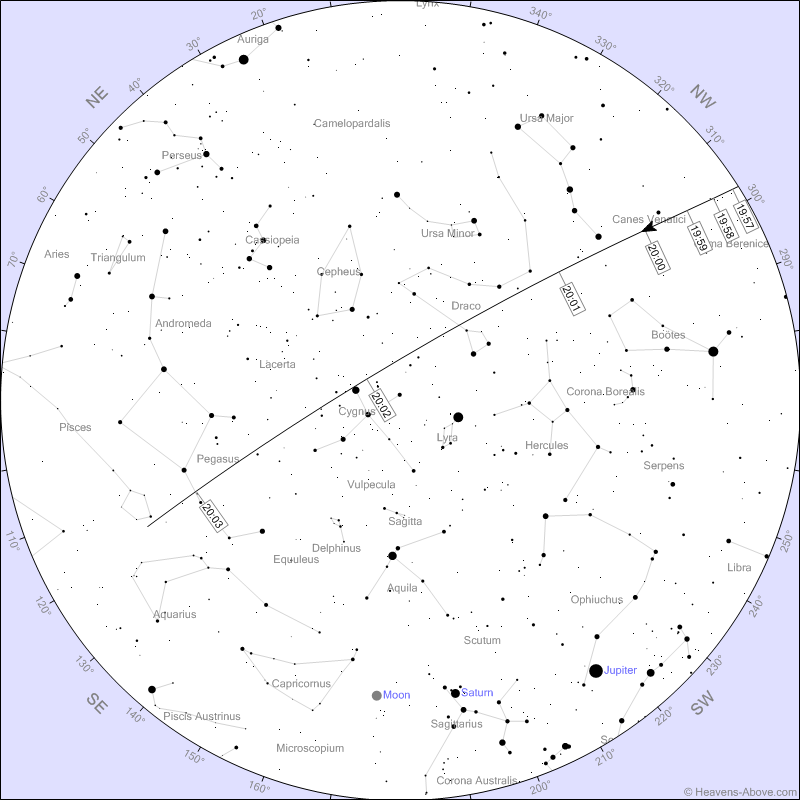Greater Toronto Area ISS Passes for the week of October 6th, 2019

On Saturday, October 6 from 7:59 to 8:03 pm EDT, the International Space Station will glide high over the GTA in a very bright pass, rising from the west-northwestern horizon, passing near the bright star Deneb, and then disappearing into Earth’s shadow over the east-southeastern horizon.
The ISS (International Space Station) is visible gliding silently over the GTA this week. The best passes at (mostly) convenient times are listed below. (Note: The more negative the Mag. number, the brighter. The larger the Alt. number, the higher up it is!) Some passes are high and bright! (Data adapted from www.Heavens-above.com. If you enter your location in their website, you will get a list of them for your location.) All the times are in Eastern Time.
Date Start & End Times (EDT) Direction of Travel Max Alt. Mag.
Sun, 6-Oct 7:58:36 pm to 8:03:36 pm moves WNW to ESE 82° -3.9 !!
Mon, 7-Oct 8:47:11 pm to 8:50:09 pm moves W to SW 23° -1.8
Tue, 8-Oct 7:58:19 pm to 8:03:56 pm moves WNW to SSE 38° -2.5 !!
Wed, 9-Oct 7:09:37 pm to 7:16:13 pm moves WNW to SE 66° -3.4 !!
Thu, 10-Oct 7:58:42 pm to 8:02:41 pm moves W to S 15° -0.9
Fri, 11-Oct 7:09:29 pm to 7:15:02 pm moves W to SSE 25° -1.5
Iridium flares are glints of sunlight off of the flat reflecting sides of one of the satellites that comprise the Iridium pager and sat-phone network. The flares occur before dawn and after dusk, when the satellite passing overhead is still illuminated by the Sun, which is below the horizon for observers on the ground. The duration and brightness depend on the angles between the observer, the satellite, and the Sun. For even more info about Iridium Flares and the space station, see an article that I wrote here. The Iridium Company has largely replaced these satellites, so the flares are now rare events.
Here are this week’s best Iridium Flares for the GTA. Using an accurate clock, go outside a few minutes ahead and look in the direction indicated. You should first see the dim Iridium satellite moving quickly across the sky, and then it will rapidly brighten for 3 to 8 seconds, and fade out. Truly spectacular! The more negative the Magnitude number, the brighter. The larger the Alt. number, the higher up it is! (The horizon is 0°, and 90° is straight up, so 55° is a bit higher than halfway between the horizon and zenith.) These data are adapted from www.heavens-above.com. To get your own schedule, enter your location in their website. Click the hyperlinks to see a star chart of the pass.
Date and Time (EDT) Mag. Alt. Direction Notes
Thu, 10-Oct at 7:17:10 pm -2.1 56° 14° (NNE) Very Bright!
Keep looking up, and enjoy the sky when you do. I love questions and requests – so, send me some!